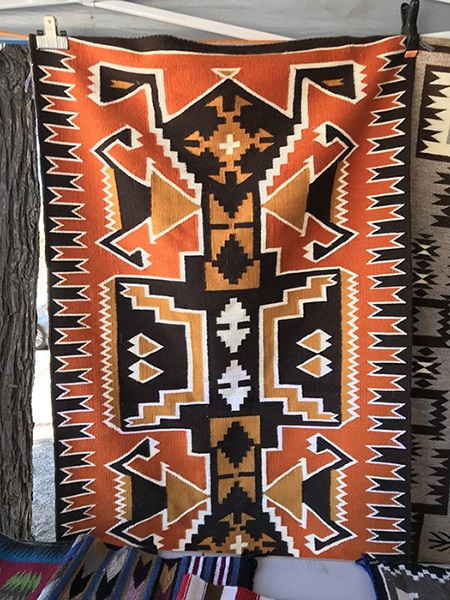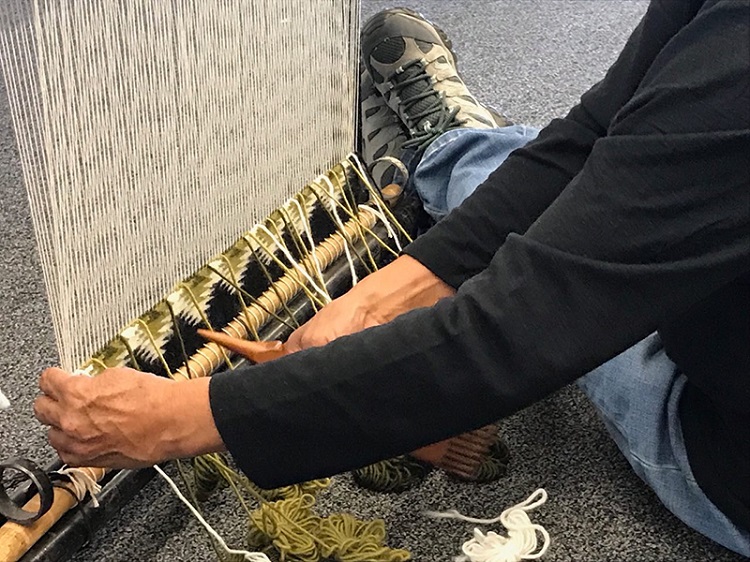 March 29, 2019—Nine Diné (Navajo) weavers, most of whom are tribal elders, will bring generations of weaving tradition to CSU Channel Islands (CSUCI) Wednesday, April 3, at the John Spoor Broome Library.
March 29, 2019—Nine Diné (Navajo) weavers, most of whom are tribal elders, will bring generations of weaving tradition to CSU Channel Islands (CSUCI) Wednesday, April 3, at the John Spoor Broome Library.
“We are here to educate our students on the people, places, and culture that is America,” said Art Lecturer Denise Lugo, who was instrumental in organizing the event. “This event allows our students to see these amazing matriarchs and have the opportunity to spend one day with them as they bring their history to our campus.”
This is the second time CSUCI and the non-profit Institute for Research on Trauma and Resilience (IRTR) have co-hosted the weavers, who come from the Black Mesa area of the western Navajo Nation in Arizona to share their traditions at a day-long celebration of the Native American experience.
The exhibition, presentations and demonstrations are part of the larger Native Voices Exhibition Program, a traveling exhibit on Native American healing that is visiting CSUCI until April 10.
“Remembrance and Renewal: Navajo Resilience through Weaving Traditions” begins at 10 a.m. in the Broome Library Plaza with a welcome, followed by presentations about preserving cultural heritage from the Honorable Roberto Rodriguez Hernandez of the Mexican Consulate.
Interim Broome Library Dean Stephen Stratton will speak along with Ivana Mora, Ph.D., and Lee Greer, Ph.D. — each co-founders of IRTR. Greer and Mora will speak about the struggles Native Americans have faced, and the value of preserving the culture of indigenous people across the nation.
 At 11 a.m. there will be a traditional Chumash blessing from CSUCI Director of Facility Support Raudel Banuelos, also the Vice Tribal Chair of the Barbareno/Ventureno Band of Mission Indians. At 1 p.m., the Diné/Navajo matriarchs will use small looms to show 25 CSUCI students how to weave a traditional rug.
At 11 a.m. there will be a traditional Chumash blessing from CSUCI Director of Facility Support Raudel Banuelos, also the Vice Tribal Chair of the Barbareno/Ventureno Band of Mission Indians. At 1 p.m., the Diné/Navajo matriarchs will use small looms to show 25 CSUCI students how to weave a traditional rug.
“They will be discussing the spiritual aspects of rug-weaving and how to represent the cosmos and the four corners of the world in each weaving,” Mora said.
Mora became interested in the Diné/Navajo because of their struggles linked to U.S. government uranium mining from World War II through 1971. The mining led to high rates of lung cancer, which resulted in the 1990 passage of the Radiation Exposure Compensation Act. The struggle on the land where the Navajo have lived for hundreds of years continues.
“They’re trying to hold onto their land,” Mora said. “They’re having their animals repossessed, they’re living without water and electricity. It’s a struggle for them just to survive. The weavings are a key source of income.”
According to Mora, when they visited CSUCI last year and were able to sell many of their handmade rugs, they experienced a renewal of optimism and have been excited to bring their weavings back to campus this year. They also plan to bring handmade jewelry and pottery for display and sale.
Lugo, who is a friend of Mora’s, became interested in the Navajo’s matriarchal society and the significance of their woven rugs, so she approached Mora last year with the idea of bringing the Navajo women to the CSUCI campus so that students and the public could get an even broader idea of diversity, and of people who have fought to keep their culture intact.
For more on the weavers: www.migrations.com/blackmesa/weavingsforsale.html.
For more on the Institute for Research on Trauma and Resilience: https://irtresilience.org/.
